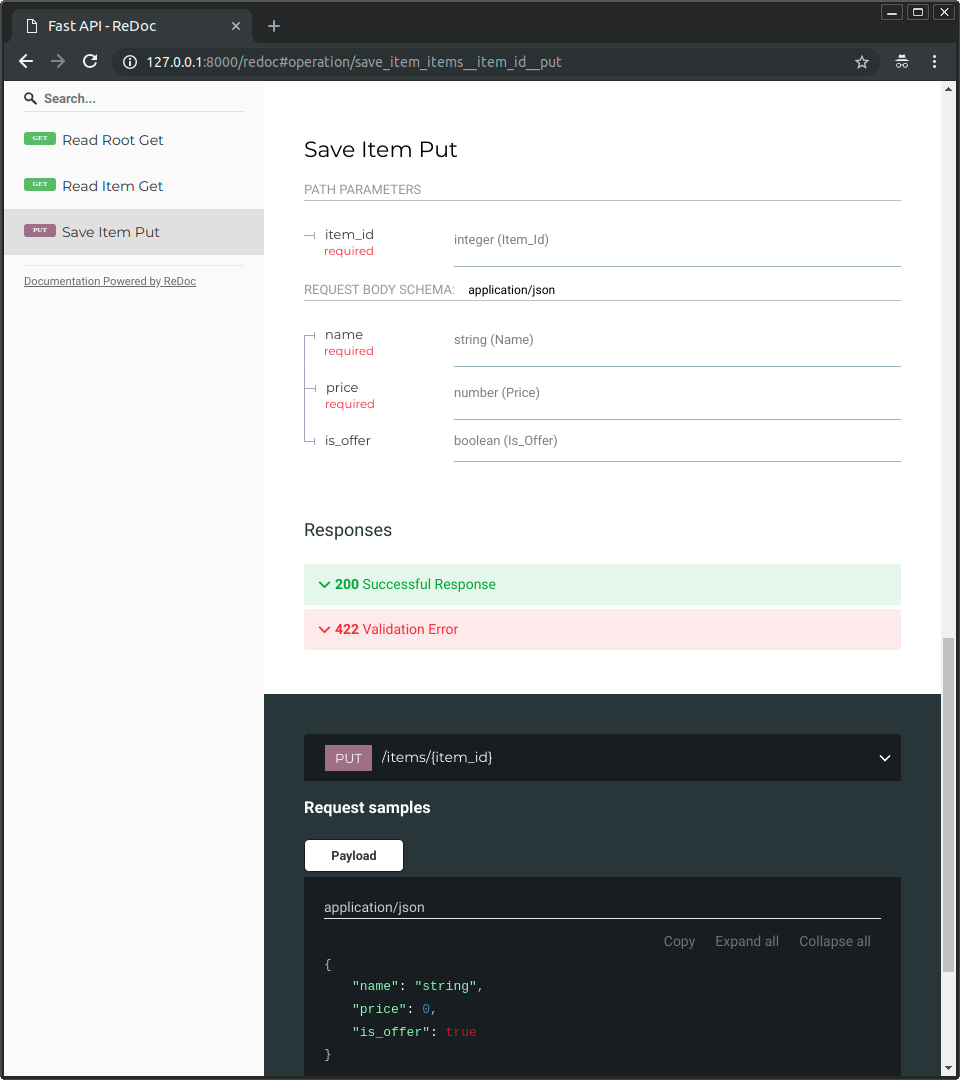- Sort Score
- Result 10 results
- Languages All
Results 101 - 110 of 544 for model1 (0.04 sec)
-
docs/de/docs/advanced/events.md
Stellen wir uns vor, dass das Laden des Modells **eine ganze Weile dauern** kann, da viele **Daten von der Festplatte** gelesen werden müssen. Sie möchten das also nicht für jeden Request tun.
Registered: Sun Sep 07 07:19:17 UTC 2025 - Last Modified: Mon Nov 18 02:25:44 UTC 2024 - 9K bytes - Viewed (0) -
docs/en/docs/advanced/response-directly.md
# Return a Response Directly { #return-a-response-directly } When you create a **FastAPI** *path operation* you can normally return any data from it: a `dict`, a `list`, a Pydantic model, a database model, etc. By default, **FastAPI** would automatically convert that return value to JSON using the `jsonable_encoder` explained in [JSON Compatible Encoder](../tutorial/encoder.md){.internal-link target=_blank}.Registered: Sun Sep 07 07:19:17 UTC 2025 - Last Modified: Sun Aug 31 09:15:41 UTC 2025 - 3.1K bytes - Viewed (0) -
docs/em/docs/tutorial/extra-models.md
Sebastián Ramírez <******@****.***> 1731896744 +0100
Registered: Sun Sep 07 07:19:17 UTC 2025 - Last Modified: Mon Nov 18 02:25:44 UTC 2024 - 5.7K bytes - Viewed (0) -
docs/fr/docs/advanced/response-directly.md
# Renvoyer directement une réponse Lorsque vous créez une *opération de chemins* **FastAPI**, vous pouvez normalement retourner n'importe quelle donnée : un `dict`, une `list`, un modèle Pydantic, un modèle de base de données, etc. Par défaut, **FastAPI** convertirait automatiquement cette valeur de retour en JSON en utilisant le `jsonable_encoder` expliqué dans [JSON Compatible Encoder](../tutorial/encoder.md){.internal-link target=_blank}.
Registered: Sun Sep 07 07:19:17 UTC 2025 - Last Modified: Sat Nov 09 16:39:20 UTC 2024 - 3.6K bytes - Viewed (0) -
docs/en/docs/advanced/generate-clients.md
You can see those schemas because they were declared with the models in the app. That information is available in the app's **OpenAPI schema**, and then shown in the API docs. That same information from the models that is included in OpenAPI is what can be used to **generate the client code**. ### Hey API { #hey-api }
Registered: Sun Sep 07 07:19:17 UTC 2025 - Last Modified: Sun Aug 31 09:15:41 UTC 2025 - 10.1K bytes - Viewed (0) -
docs/en/docs/advanced/settings.md
Import `BaseSettings` from Pydantic and create a sub-class, very much like with a Pydantic model. The same way as with Pydantic models, you declare class attributes with type annotations, and possibly default values. You can use all the same validation features and tools you use for Pydantic models, like different data types and additional validations with `Field()`. //// tab | Pydantic v2
Registered: Sun Sep 07 07:19:17 UTC 2025 - Last Modified: Sun Aug 31 09:15:41 UTC 2025 - 12.2K bytes - Viewed (0) -
okhttp-logging-interceptor/Module.md
# Module okhttp-logging-interceptor
Registered: Fri Sep 05 11:42:10 UTC 2025 - Last Modified: Tue Apr 02 11:27:49 UTC 2019 - 102 bytes - Viewed (0) -
module.xml
<url url="${repo.url}/${module.groupId}/${module.name.prefix}${module.name}/${module.version}/${module.name.prefix}${module.name}-${module.zip.version}.zip" /> </get> <unzip dest="${modules.dir}/${module.name}" src="${target.dir}/${module.name.prefix}${module.name}-${module.zip.version}.zip"> <patternset> <include name="**" /> </patternset> <cutdirsmapper dirs="1" /> </unzip> </target> <target name="remove.jars" if="with.fess">Registered: Thu Sep 04 12:52:25 UTC 2025 - Last Modified: Sun Aug 31 08:19:00 UTC 2025 - 3.9K bytes - Viewed (0) -
docs/fr/docs/features.md
from datetime import date from pydantic import BaseModel # Déclare une variable comme étant une str # et profitez de l'aide de votre IDE dans cette fonction def main(user_id: str): return user_id # Un modèle Pydantic class User(BaseModel): id: int name: str joined: date ``` Qui peuvent ensuite être utilisés comme cela: ```Python my_user: User = User(id=3, name="John Doe", joined="2018-07-19")
Registered: Sun Sep 07 07:19:17 UTC 2025 - Last Modified: Tue Aug 06 04:48:30 UTC 2024 - 11.1K bytes - Viewed (0) -
docs/en/docs/features.md
 ### Just Modern Python { #just-modern-python } It's all based on standard **Python type** declarations (thanks to Pydantic). No new syntax to learn. Just standard modern Python.Registered: Sun Sep 07 07:19:17 UTC 2025 - Last Modified: Sun Aug 31 09:15:41 UTC 2025 - 9.5K bytes - Viewed (0)